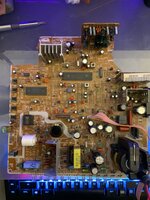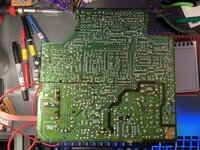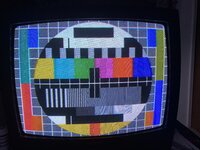LeoRetro
Newbie
I could use guidance on further troubleshooting a hidden fault that is leading me into circuitry and voltages I am not entirely familiar with. Given the voltages involved I decided it best to seek proper support before taking my most expensive tool, my multimeter, to it haphazardly. Below is the model, the symptoms it’s suffering, the steps I have taken, and my theory of where I need to go next with it. If someone could point me in the proper direction, my tools are limited to a high-quality multimeter, fine tipped Pinecil soldering iron, and a -mostly- similar Samsung service manual.
Curtis Mathes model CM 19022S
Circa 2001 - owner since 2004
Samsung based budget 19” CRT with Composite Stereo and RF inputs.
Symptom: faint blue phosphor activation across entire screen in a “trace pattern” zig-zagging from right down to left, wiping horizontal and repeating; stays fairly static, with a more subtle rolling “noise” across whole effect. Appears unaffected by any user or technician serviceable adjustment to Brightness, Contrast, Tint, or even SC
Steps taken:
1: replaced all large-dimension electrolytic capacitors with matching or slightly higher voltage/temperate tolerance capacitors
2: rotated neck-board trio of transistors to see if symptom changed color.
3: inspected main PCB and Neckboard for any solder defects; took advantage of opportunity to practice desoldering/resoldering most joins, transistors, IC’s as a matter of practice with my tools.
I can say image brightness and stability has improved and I even got a crash-course on convergence/purity upon discovering those rings were not factory cemented; but instead thumb-tightened. But the primary symptom remains.
I’m concerned this MAY be due to heater/cathode short, but until would be willing to use this opportunity to learn more about the circuit pathways driving the voltages to this mad-science in an over-sized bottle I’ve loved since child-hood.
Curtis Mathes model CM 19022S
Circa 2001 - owner since 2004
Samsung based budget 19” CRT with Composite Stereo and RF inputs.
Symptom: faint blue phosphor activation across entire screen in a “trace pattern” zig-zagging from right down to left, wiping horizontal and repeating; stays fairly static, with a more subtle rolling “noise” across whole effect. Appears unaffected by any user or technician serviceable adjustment to Brightness, Contrast, Tint, or even SC
Steps taken:
1: replaced all large-dimension electrolytic capacitors with matching or slightly higher voltage/temperate tolerance capacitors
2: rotated neck-board trio of transistors to see if symptom changed color.
3: inspected main PCB and Neckboard for any solder defects; took advantage of opportunity to practice desoldering/resoldering most joins, transistors, IC’s as a matter of practice with my tools.
I can say image brightness and stability has improved and I even got a crash-course on convergence/purity upon discovering those rings were not factory cemented; but instead thumb-tightened. But the primary symptom remains.
I’m concerned this MAY be due to heater/cathode short, but until would be willing to use this opportunity to learn more about the circuit pathways driving the voltages to this mad-science in an over-sized bottle I’ve loved since child-hood.
Attachments
-
 FB7ABC05-693E-4574-8F31-CD2D9BE1C5BA.jpeg1,004 KB · Views: 234
FB7ABC05-693E-4574-8F31-CD2D9BE1C5BA.jpeg1,004 KB · Views: 234 -
 31D818D2-FFB2-4DB2-809E-CD8B82D4C17E.jpeg1 MB · Views: 226
31D818D2-FFB2-4DB2-809E-CD8B82D4C17E.jpeg1 MB · Views: 226 -
 7730433B-7C2E-4100-9476-82A94F1B4769.jpeg2.3 MB · Views: 231
7730433B-7C2E-4100-9476-82A94F1B4769.jpeg2.3 MB · Views: 231 -
 46850795-CEE0-4DAD-B5ED-9EEE6E919049.jpeg3.2 MB · Views: 227
46850795-CEE0-4DAD-B5ED-9EEE6E919049.jpeg3.2 MB · Views: 227 -
 646C1EE5-91DE-4328-945C-1B3BDDD07781.jpeg5.8 MB · Views: 217
646C1EE5-91DE-4328-945C-1B3BDDD07781.jpeg5.8 MB · Views: 217